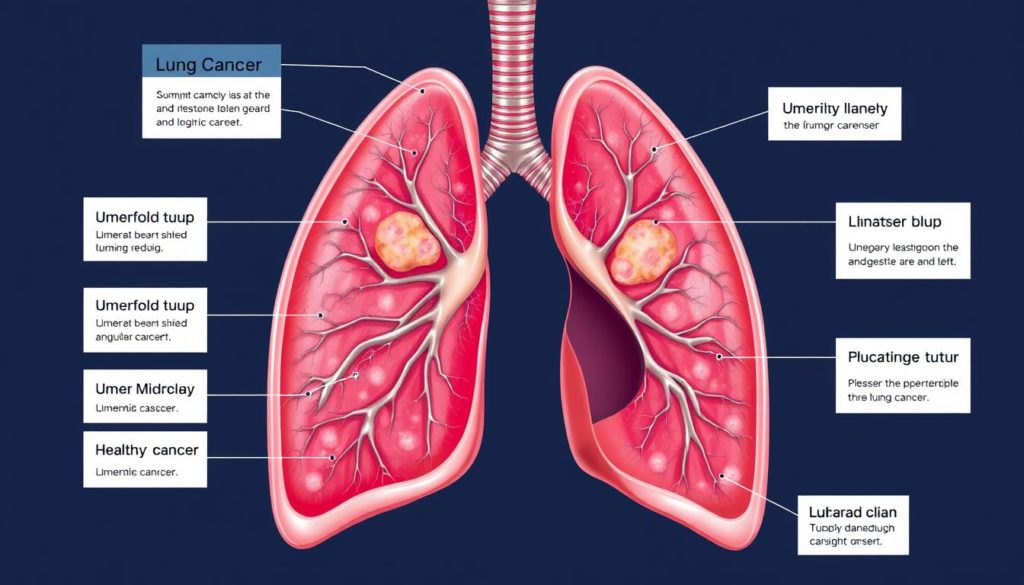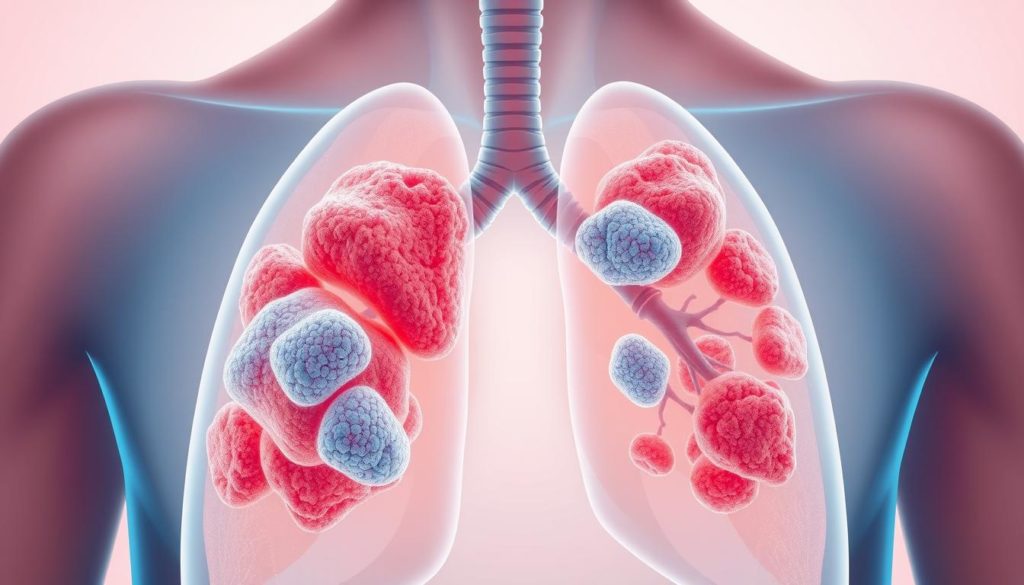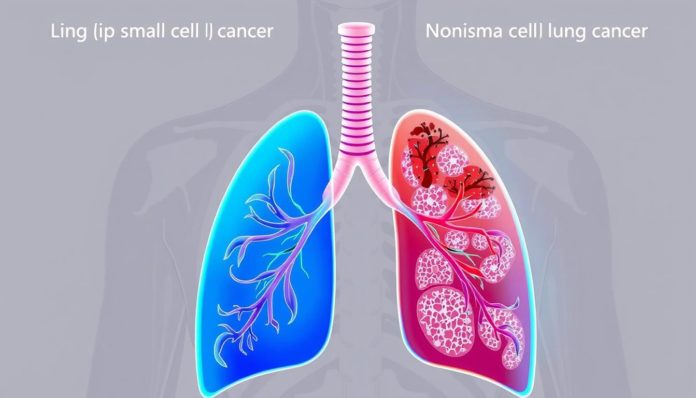Lung cancer causes many deaths around the world each year. About 1.8 million people die from it annually. It’s important to know about lung cancer to help prevent these deaths.
Lung cancer starts in the lungs, which are like sponges in your chest. There are two main kinds: non-small cell lung cancer (NSCLC) and small cell lung cancer (SCLC). Knowing about these types helps in finding the right treatment.
The lungs help you breathe by getting oxygen in and carbon dioxide out. But lung cancer can affect this process. It’s essential to learn all about lung cancer to protect this critical system.
Most lung cancers are NSCLC, including types like adenocarcinoma, squamous cell carcinoma, and large cell carcinoma. Adenocarcinoma is the most common, affecting smokers and non-smokers. SCLC spreads quickly and is often linked to smoking.
There are also rare lung cancers, such as lung carcinoid tumors. These grow differently. Understanding all lung cancer types is key to better lung health and tackling the disease effectively.
Introduction to Lung Cancer
Lung cancer is key to understand because of its many effects on people. The lungs, under the pleura’s protection and moved by the diaphragm, are core to our breathing. Lung cancer starts when harmful cells grow in these tissues, causing big health problems. It’s key to know the two main kinds, Non-Small Cell Lung Cancer (NSCLC) and Small Cell Lung Cancer (SCLC). NSCLC includes adenocarcinoma, squamous cell carcinoma, and large cell carcinoma. SCLC grows quickly and is very serious.

Lung cancer risks don’t just affect smokers. Many non-smokers can get it too, showing it’s not just about lifestyle choices. This points to the need for wider Oncology Insights to fight and manage the disease.
Understanding the big picture and specific types of lung cancer is crucial. Knowing more about oncology helps with better diagnosis and treatment. Looking closer at these details shows how big the disease’s impact is. It also shows how crucial early finding and special treatments are.
Non-Small Cell Lung Cancer: An Overview
Non-Small Cell Lung Cancer (NSCLC) makes up about 80%-85% of lung cancer cases. It includes several types of lung cancer that are treated and progress similarly. Knowing about NSCLC Subtypes helps doctors find the best treatment plan. Let’s examine Adenocarcinoma, Squamous Cell Carcinoma, and Large Cell Carcinoma in detail.

Adenocarcinoma
Adenocarcinoma is lung cancer that starts in the cells lining the lungs. It’s the most common type, especially in women and young people. Both smokers and non-smokers can develop it. This cancer usually begins in the lung’s outer parts and is often caught early, which helps treatment work better.
Squamous Cell Carcinoma
Squamous Cell Lung Cancer comes from flat cells in the airways and is mainly due to smoking. It’s often found in the central part of the lungs, close to the bronchus. It grows slowly, which means it can often be caught early. Stopping smoking is crucial for preventing this cancer type.
Large Cell Carcinoma
Large Cell Carcinoma can be very aggressive, spreading quickly. It can start in any part of the lung. This group includes a very fast-growing type called large cell neuroendocrine carcinoma. It needs quick and strong treatment. Getting the right diagnosis and a tailored treatment plan is vital for helping patients.
Small Cell Lung Cancer: What You Need to Know
Small Cell Lung Cancer (SCLC) makes up a smaller share of lung cancer cases, but it’s very aggressive. It grows quickly, often spreading before it’s even found. This makes treating it and predicting outcomes tough.
Characteristics of SCLC
SCLC is known for growing fast and spreading early. Smoking is a big cause of this type of lung cancer. It has types called small cell carcinoma and mixed small cell/large cell. Catching and treating it early is crucial.
Treatment Options for SCLC
Treatment for Small Cell Lung Cancer usually combines chemotherapy and radiation therapy. These treatments often work well at first. But, the cancer can come back, making the fight against SCLC hard. Research to find better treatments continues to be essential.
Types of Lung Cancer: Main Categories and Subtypes
Lung cancer is a complex illness with many different types. It’s essential to pinpoint the exact type to choose the best treatment. Lung cancer is mainly divided into Non-Small Cell Lung Cancer (NSCLC) and Small Cell Lung Cancer (SCLC). Each type affects patients in different ways.
Non-Small Cell Lung Cancer (NSCLC) makes up about 80% of lung cancer cases. It includes several subtypes:
- Adenocarcinoma: This common NSCLC subtype usually starts in the lung’s outer parts. It’s more common in non-smokers and women. Adenocarcinomas grow more slowly than others.
- Squamous Cell Carcinoma: Found near the center of the lungs, this type is linked to smoking. It often leads to symptoms like coughing and chest pain.
- Large Cell Carcinoma: Known for its big, odd cells, this cancer can develop anywhere in the lung. It tends to spread fast.
Small Cell Lung Cancer (SCLC) accounts for about 15% of lung cancers. It grows and spreads quickly. SCLC is mainly split into two subtypes:
- Pure Small Cell Carcinoma: The most common SCLC type, known for rapid growth and early spread.
- Combined Small Cell Carcinoma: A rare mix of small cell and non-small cell features.
Knowing the specific Lung Cancer Subtypes is key for doctors. It helps them create tailored treatments for each patient. Advanced tests play a big role in figuring out the cancer type, improving chances for a better outcome.
Rare Types of Lung Tumors
Most people have heard of non-small cell lung cancer and small cell lung cancer. These are the common types. But, there are rare lung cancers that need attention too. One of these is lung carcinoid tumors. They are quite rare, accounting for less than 5% of all lung tumors.
Carcinoid Tumors
Lung carcinoid tumors start from neuroendocrine cells in the lungs. They come in two types: typical and atypical. Typical carcinoid tumors grow slowly and almost never spread. But, atypical carcinoid tumors might grow faster and spread to other body parts.
Surgery is the main treatment for lung carcinoid tumors. If surgery can’t be done, doctors may use chemotherapy and radiation. The treatment plan depends on how the tumor acts and the patient’s health.
Apart from lung carcinoid tumors, other rare lung cancers like adenoid cystic carcinomas, lymphomas, and sarcomas exist. These cancers need special care and specific treatments. This makes them different from the more common lung cancers.
To understand these rare lung tumors better, let’s compare their traits and treatments:
| Type of Tumor | Characteristics | Treatment Options |
|---|---|---|
| Typical Carcinoid Tumors | Slow-growing, rare metastasis | Surgery, limited chemotherapy/radiation |
| Atypical Carcinoid Tumors | Faster-growing, possible metastasis | Surgery, chemotherapy, radiation |
| Adenoid Cystic Carcinomas | Rare, slow growth but can be aggressive | Surgery, radiation |
| Lymphomas | Originates from lymphatic system, varies in severity | Chemotherapy, immunotherapy, radiation |
| Sarcomas | Originate from connective tissues, rare in lungs | Surgery, chemotherapy, radiation |
Mesothelioma: A Rare But Serious Form of Lung Cancer
Mesothelioma is a rare cancer affecting the lung and chest lining, mainly due to asbestos exposure. Known as Asbestos-Related Cancer, its impact is severe with a long latency period. Despite being uncommon, its connection to work-related hazards is significant.
Symptoms like chest pain and breath shortness show up decades after asbestos contact, making diagnosis difficult. Diagnosis usually involves imaging tests and biopsies for tumor assessment. This process helps understand the cancer’s development stage.
Treatment depends on cancer’s stage and the patient’s health. Options include:
- Chemotherapy: Shrinks tumors and destroys cancer cells.
- Radiation Therapy: Focuses on reducing tumor size and symptom relief.
- Surgery: Removes cancerous lung tissue to eliminate cancer cells.
Often, doctors use a blend of these methods for the best outcomes. Lung cancer experts create personalized treatment plans for every patient. This tailored approach helps in managing the disease more effectively.
Preventing mesothelioma requires reducing asbestos exposure, especially in high-risk jobs. Making the workplace safe and teaching workers about asbestos risks are key steps. Proper safety practices can greatly cut down the chance of getting this Asbestos-Related Cancer.
Lung Nodules: Benign and Malignant Variants
Lung nodules are tiny tissue masses found in the lungs. They can be either benign or malignant. These nodules are usually found by accident during imaging tests for other health issues. Knowing what kind of nodule it is, is key for the right treatment.
Identification and Diagnosis
To spot and diagnose lung tumors, doctors use imaging like X-rays or CT scans. If a nodule shows up, more tests such as PET scans or biopsies might be done. The size of the nodule is very important, as bigger ones could be more dangerous.
Treatment Options
Treating lung nodules depends on if they are benign or malignant. If a nodule is benign, doctors might just watch it closely over time. But, if the nodule is malignant, treatments like surgery, chemotherapy, or radiation might be needed. The treatment plan is made to fit each person’s health situation.
Factors Leading to Different Lung Cancer Types
Many factors play a big role in the types of lung cancer people get. Knowing what causes lung cancer is key for prevention and treatment. Smoking is one of the main lung cancer risk factors. Studies prove that smoking greatly increases the chance of getting non-small cell lung cancer (NSCLC) and small cell lung cancer (SCLC).
- Genetic predispositions: Having lung cancer in the family raises your risk.
- Environmental exposures: Around 20% of non-smokers with lung cancer were exposed to secondhand smoke, radon gas, or pollutants.
- Occupational risks: Working with asbestos, nickel, chromium, and arsenic increases lung cancer chances.
It’s critical to understand these factors for prevention and creating specific treatments. For instance, asbestos is a top cause of mesothelioma, a rare but deadly lung cancer. These insights guide doctors in making targeted treatment plans.
| Factor | Influence on Lung Cancer Types |
|---|---|
| Smoking | Increases risk for both NSCLC and SCLC |
| Genetic Predispositions | Elevated risk if family history is present |
| Environmental Exposures | Contributes significantly among non-smokers |
| Occupational Risks | Higher rates associated with asbestos, nickel, chromium, and arsenic |
Knowing these lung cancer risk factors lets people and doctors tackle the causes of lung cancer more effectively. This boosts the chances of preventing the disease.
Advancements in Lung Cancer Treatments
The fight against lung cancer has seen huge progress. We now have Lung Cancer Innovations that are changing how we care for patients. One of the big leaps is targeted therapies. These focus on specific genes in cancer cells, leaving healthy cells alone. This approach makes treatment both more effective and kinder to the body.
Targeted Therapy
Targeted Therapy Breakthroughs are changing the game in lung cancer care. They include ALK inhibitors, EGFR inhibitors, and ROS1 inhibitors. These are special because they attack cancer cells with specific genetic changes. Studies are showing that this can lead to better outcomes for patients. It’s a step towards care that’s tailored to each person. For more info on this research, check out this link.
Immunotherapy
Immunotherapy for Lung Cancer is another game-changer. It uses our own immune system to fight cancer. This approach has been focused on immune checkpoint inhibitors in research. The findings? Patients are living longer, better lives. By adding Immunotherapy to other treatments, we’re seeing even more benefits.
Through targeted therapy and immunotherapy, the push for better lung cancer treatments never stops. Ongoing research promises new hope and ways to care for patients. The journey of discovery, as shown here, is paving the way for a brighter future in lung cancer treatment.
Importance of Early Detection and Screening
Lung cancer screening is key for better outcomes, especially for high-risk groups. Using yearly low-dose CT scans helps find lung issues early. This is when they are easiest to treat. People who have smoked a lot gain the most from screenings. They can catch cancer early, which might save their lives.
Finding lung cancer early boosts the chance of beating it. It also means a better life for those diagnosed. Because lung cancer can be hard to notice early, regular screenings are crucial. As per the American Cancer Society, screenings are life-saving. They stress how vital it is to reach those who need them most.
Talking to a doctor about lung cancer screening is important. It’s key to understand the risks, like radiation. Also, there might be more tests if they find something. Informed talks help people make the right choices about their health. So, more people knowing and using early detection tools can really make a difference in fighting lung cancer in the US.
FAQ
What are the main types of lung cancer?
The main types of lung cancer are NSCLC and SCLC. NSCLC includes adenocarcinoma, squamous cell carcinoma, and large cell carcinoma. SCLC grows and spreads quickly, though it’s less common.
What is adenocarcinoma of the lung?
Adenocarcinoma is a kind of NSCLC. It starts in the cells lining the lungs. It’s the most common lung cancer in smokers and nonsmokers. Women and young people get it often.
How is squamous cell carcinoma different from other lung cancers?
Squamous cell carcinoma comes from flat cells in the airways. It’s linked to smoking. It forms near the bronchus, different from adenocarcinoma that occurs in the lung’s outer areas.
What distinguishes large cell carcinoma in lung cancer?
Large cell carcinoma is a fast-growing NSCLC. It can start in any lung area. This subtype includes highly aggressive large cell neuroendocrine carcinoma, known for quick metastasis.
Why is small cell lung cancer (SCLC) considered aggressive?
SCLC grows fast and spreads early. It’s mostly caused by smoking. Early detection is rare, requiring immediate treatment with chemotherapy and radiation.
What are typical and atypical lung carcinoid tumors?
Carcinoid tumors come from neuroendocrine cells. Typical carcinoids grow slowly with rare metastasis. Atypical ones grow faster and are more likely to spread.
How does mesothelioma relate to lung cancer?
Mesothelioma is rare. It affects the pleura around the lungs. Asbestos exposure causes it. Treatment includes chemotherapy, radiation, and surgery.
What should one know about lung nodules?
Lung nodules are small tissue masses in the lungs. They can be benign or malignant. They’re usually found during other tests. Treatment depends on the nodule’s nature.
What are the primary factors leading to lung cancer?
Smoking is the biggest risk factor for lung cancer. Genetic traits, environmental elements like asbestos, and job hazards also contribute.
What are the latest advancements in lung cancer treatment?
New treatments include targeted therapies and immunotherapy. They attack cancer’s genetic aspects or boost the immune system. This offers hope for more effective treatments.
How important is early detection and screening for lung cancer?
Detecting and screening early is key to fighting lung cancer. Screenings, especially for smokers, can catch it early. This improves the chances of successful treatment.


